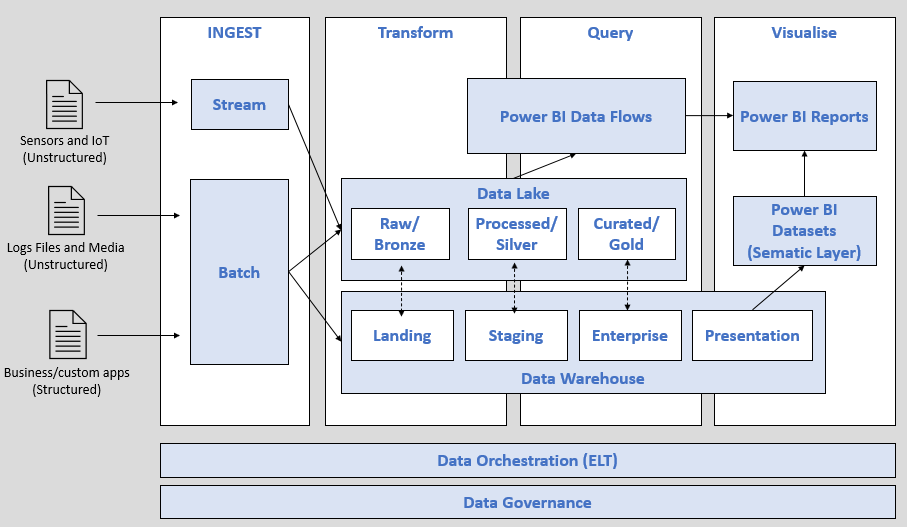Introducing the Data Powerhouse: A Hybrid Modern Data Platform
The Data and Analytics services space has gone through a lot of changes in the last decade. UK government now has an AI action plan and Data Governance is more important than ever. However, most notable has been the democratisation of Data Analytics, or put another way, the ability for many more organisations to benefit from the insight that can be derived from the data that already flows around their organisation. This has occurred because of the reduction of a couple of key barriers to entry; Cost and Complexity.
From Expensive Appliances to Cloud-Native Platforms
Cost and complexity arguably go hand in hand. A decade ago handling big data typically meant an organisation had to invest in a dedicated appliance such as Netezza, an IBM Mainframe or Microsoft’s Parallel Data Warehouse; an investment that typically cost hundreds of thousands of pounds. This presented a significant barrier to entry for all but the largest organisations.
Open-source technologies such as Hadoop and the advent of data lakes helped reduce these costs. However, they often introduced new complexities. Managing data lakes, working with non-relational structures, and building SQL-like functionality from scratch can challenge even the most experienced teams.
This evolution gave rise to the Lakehouse model, an architecture designed to blend the affordability of data lakes with some of the structure of data warehouses. However, the downside of lakehouse is complexity. Whilst strides continue to be made in what is possible outside of a relational engine using SQL there are often limitations and the very administration of these environments can also be a challenge.
A Unified Vision: The Data Powerhouse
So, how do we bring together some of the cost, capacity and simplicity of access benefits of the Lakehouse with the familiarity an ease of use the relational Data Warehouse? Enter the Data Powerhouse.
The idea behind the Data Powerhouse is to take the relevant parts of the Power Platform (specifically Power BI), Lakehouse and Warehouse and put them together. This ‘pick and mix’ approach is obviously facilitated by the low-cost availability of these technologies as pay as you go cloud services. This means you no longer have to decide between Lakehouse or Warehouse. This results in a conceptual architecture that looks like this (shout out to Mike Dobing from SQL of the North for the structure of this diagram):

Key Aspects of the Data Powerhouse Architecture
- Data can be pushed either through the Lake or the Warehouse, with cross fertilisation possible (i.e. IoT Datasets once processed maybe Staging candidates within the Warehouse and anonymous datasets from Business/Custom Apps could be made available via the Lake from the Warehouse).
- End users are expected to predominantly access the Lake via Power BI Data Flows.
- Early access to Processed Datasets is facilitated for Tactical / Operational reporting whilst the facility to fully model out to a Presentation layer and Power BI Datasets remains.
- The Data Warehouse can be either Synapse or Azure SQL Server Based.
Looking Ahead: The Role of Power BI Dataflows
An exciting possibility for the future is using Power BI Dataflows not just for analysis, but also as a processing engine. With enhanced support for common data models and delta/parquet formats, organisations could reduce reliance on third-party tools like Azure Data Factory.
This would streamline data engineering, minimise duplication of effort, and help accelerate cloud data solution adoption using Microsoft Fabric implementation and Power BI services to create a true end-to-end platform for insight generation.
Conclusion
The Data Powerhouse represents a powerful step forward in hybrid data architecture. By leveraging the strengths of Microsoft Fabric consulting services, Power BI, and cloud data solutions, organisations can overcome the limitations of traditional platforms while unlocking agility, insight, and cost-efficiency.
For those looking to modernise their data ecosystem, embrace the Lakehouse-Warehouse hybrid, and maximise return on investment, the Data Powerhouse offers a clear and scalable path forward.
How Simpson Associates can Help You
Simpson Associates are a Microsoft Solutions Partner with Partner of the Year Award win in 2024/2025. we can provide expertise around modern data platforms, having previous experience working with Microsoft as a partner and a number of clients. We have access to subject matter experts in the field with real hands-on knowledge of all things data.
At Simpson Associates, we have hands-on experience in providing state of the art data governance solutions using Microsoft Purview. We have also worked with clients like the Sovini Group in Microsoft Fabric Implementation. If you have questions regarding Data Powerhouse, feel free to reach out to us via email or our live chat.
Blog Author:
William Rathbone, Principal Consultant at Simpson Associates


